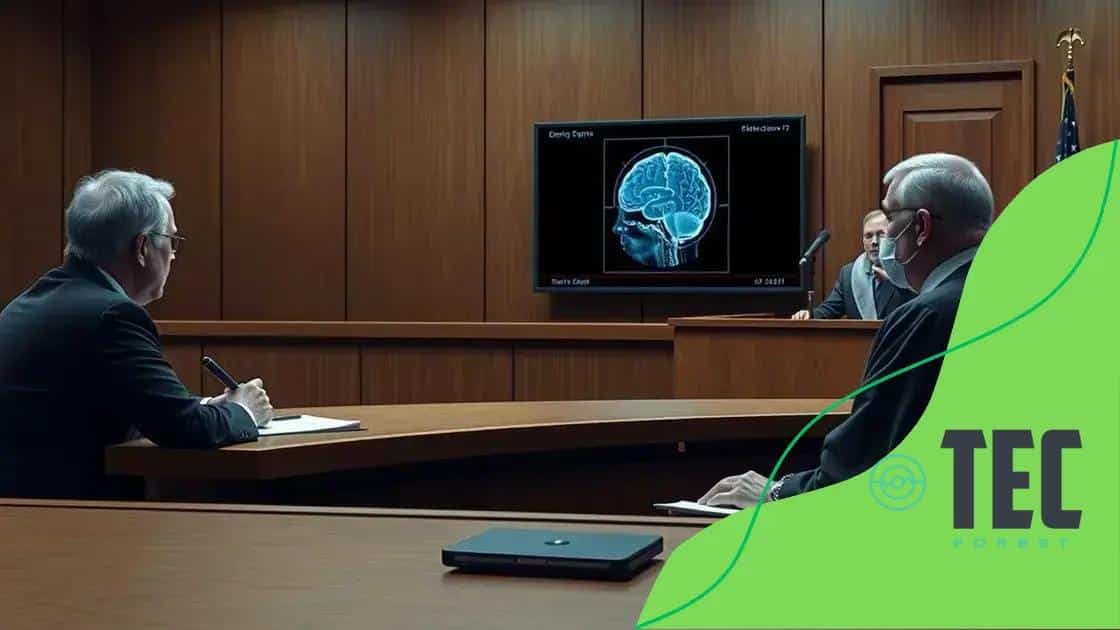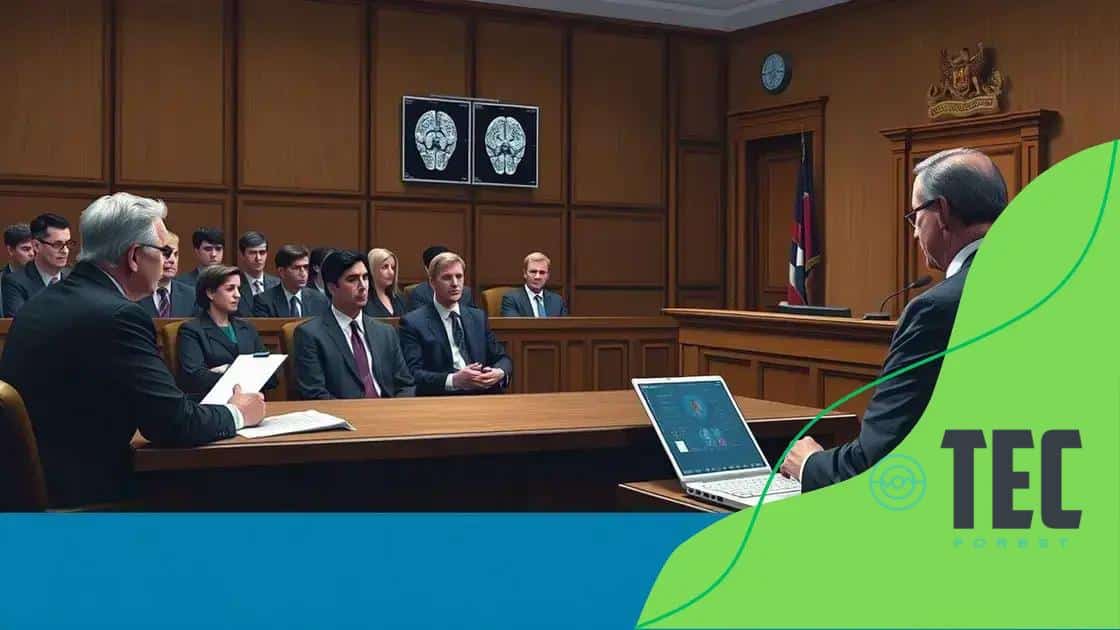Advertisement
Brain fingerprinting tools analyze brainwave patterns to assess an individual’s knowledge related to crimes, offering potential benefits for legal cases while raising important ethical considerations.
Brain fingerprinting tools are making their way into courtroom debates, raising intriguing questions about the validity and reliability of evidence. Have you wondered how these innovations might change our understanding of justice?
Advertisement
Understanding brain fingerprinting technology
Understanding brain fingerprinting technology involves exploring its scientific basis and applications in various fields. This innovative method analyzes brainwave patterns to determine if a person recognizes specific information or stimuli. It’s not just a fascinating concept; it’s a breakthrough in forensic science.
How It Works
Brain fingerprinting utilizes electroencephalography (EEG) to capture electrical activity in the brain. When a subject is shown words, images, or sounds related to a crime, their brain reacts in predictable ways. This reaction helps determine whether they possess knowledge relevant to the case.
Advertisement
Key Components
- Components: EEG equipment and software analyze brain signals.
- Data Analysis: Patterns identified indicate recognition of information.
- Applications: Used in criminal investigations and national security.
The accuracy of brain fingerprinting is remarkable, often claiming a high rate of reliability. However, it is important to consider the ethical implications and potential for misuse. This technology raises questions about privacy and consent, making its deployment in legal systems something to approach cautiously.
As we further explore the potential of this technology, the future looks promising but complex. Together, let’s delve into the challenges and advantages that brain fingerprinting brings to the courtroom.
How brain fingerprinting is used in legal cases

How brain fingerprinting is used in legal cases is a critical aspect of understanding its impact on the justice system. This technology offers unique insights into the minds of suspects by examining their brainwave responses to specific stimuli related to a crime.
Application in Courtrooms
Brain fingerprinting can serve as a powerful tool in both criminal and civil cases. In criminal proceedings, it helps ascertain whether a suspect has knowledge of undisclosed facts, like crime scene details. This evidence can potentially prove innocence or confirm guilt.
Benefits of Brain Fingerprinting
- Objective Evidence: Provides a scientific basis for claims of innocence or guilt.
- Reduction of Wrongful Convictions: Helps in exonerating innocent individuals.
- Complement to Traditional Evidence: Offers additional support alongside witness testimony and forensic evidence.
Defense attorneys may use brain fingerprinting to establish reasonable doubt. If the technology suggests a suspect did not recognize key evidence, it could strengthen their case significantly. Conversely, prosecutors might leverage it to reinforce their arguments when individuals show recognition of critical information associated with a crime.
Despite its potential, the use of brain fingerprinting raises important questions. Issues surrounding the reliability of data and individual rights need careful consideration. Courts must evaluate the admissibility of such evidence, ensuring it meets established legal standards.
Advantages and challenges of brain fingerprinting
Advantages and challenges of brain fingerprinting play a crucial role in its acceptance within the legal system. This technology offers both significant benefits and notable concerns that need to be carefully considered.
Advantages
One of the primary advantages of brain fingerprinting is its potential to enhance the accuracy of criminal investigations. By assessing brainwave responses to specific stimuli, it provides objective data that can help clarify a suspect’s involvement in a crime. This scientific approach reduces reliance on ambiguous testimonies and subjective interpretations.
- High Reliability: Brain fingerprinting often achieves high rates of accuracy in determining recognition of information.
- Supports Innocent Individuals: This technology can help exonerate those wrongfully accused, providing a clear picture of their knowledge.
- Innovative Evidence: It adds a new dimension to forensic evidence, creating a more comprehensive case profile.
However, there are challenges associated with its implementation. One significant concern is the interpretation of data. While brain responses can indicate recognition, distinguishing between innocent knowledge and criminal awareness can be complex.
Challenges
Additionally, the ethical implications cannot be overlooked. Issues surrounding consent, privacy, and the potential for misuse arise when considering its use in legal cases. There is an ongoing debate about how to ensure that this technology is used fairly and justly.
In summary, while brain fingerprinting offers promising advantages, it also poses challenges that require careful consideration. The balance between utilizing innovative technology and respecting individual rights will be essential in its future applications.
The future of neuroscience in the courtroom

The future of neuroscience in the courtroom is likely to be shaped by advancements in technology and research. As our understanding of the human brain deepens, we can expect more scientific methods to be integrated into legal proceedings.
Emerging Technologies
Neuroscientific tools such as brain fingerprinting and functional MRI are becoming increasingly important. These technologies can provide insights into a suspect’s thoughts and memories, which may drastically alter how evidence is presented in court.
Impact on Legal Practices
- Enhanced Evidence: Neuroimaging can serve as powerful evidence, showing brain activity related to criminal knowledge.
- Better Legal Strategies: Attorneys may leverage neuroscience to build stronger cases by understanding the psychological factors influencing behavior.
- Fairer Trials: This approach could lead to more equitable outcomes, helping juries make informed decisions based on scientific data.
As neuroscience evolves, legal systems worldwide will have to adapt. Courts may begin to rely more on scientific evidence, leading to changes in how trials are conducted. This shift could create new challenges, such as the need for regulations regarding the admissibility of neuroimaging evidence.
Moreover, ethical considerations surrounding the use of neuroscience in court will be vital. Questions about consent, privacy, and the potential for misuse of data must be addressed to ensure justice is served fairly and equitably.
Ethical considerations surrounding brain fingerprinting
Ethical considerations surrounding brain fingerprinting are becoming increasingly important as this technology advances. As brain fingerprinting enters courtrooms, it raises significant questions about privacy, consent, and the potential for misuse.
Privacy Concerns
One major ethical issue is the invasion of personal privacy. Brain fingerprinting technology can reveal sensitive information about an individual’s thoughts and memories. This raises the question of whether individuals should have the right to keep their mind free from scrutiny.
Informed Consent
Obtaining informed consent is crucial. Individuals must fully understand the implications of undergoing brain fingerprinting. They should know how their data will be used, stored, and shared. If individuals feel pressured to consent, it undermines the ethical foundation of the practice.
Potential for Misuse
- Data Misinterpretation: Brain data might be misinterpreted, leading to wrongful conclusions.
- Coercive Use: Authorities could misuse this technology to compel individuals to undergo testing without adequate justification.
- Discrimination: There are risks of discrimination based on brain patterns, which could unfairly affect certain groups.
The integration of such technologies into the legal system must be approached with caution. Legislators and ethics boards need to create guidelines that protect individual rights while allowing technological advancement. Ongoing discussions about the ethical implications will be essential as this field continues to evolve.
Conclusion: Brain fingerprinting and neuroscience in the courtroom present both exciting opportunities and significant ethical challenges. As technology advances, it’s essential to balance innovation with individual rights. Ensuring informed consent, protecting privacy, and preventing misuse will be crucial in shaping the future of legal processes. By understanding these aspects, we can leverage the potential of neuroscience while safeguarding justice.
FAQ – Frequently Asked Questions about Brain Fingerprinting and Neuroscience in the Courtroom
What is brain fingerprinting?
Brain fingerprinting is a technology that analyzes brainwave patterns to determine if an individual recognizes specific information related to a crime.
What are the ethical concerns associated with brain fingerprinting?
Ethical concerns include privacy issues, the need for informed consent, and the potential for misuse of brain data by authorities.
How can brain fingerprinting be used in legal cases?
It can provide objective evidence of a suspect’s knowledge of a crime, helping to clarify their involvement or innocence.
What future implications does neuroscience have for the courtroom?
As neuroscience advances, it may lead to more scientific evidence being used in trials, raising new ethical and legal considerations.
